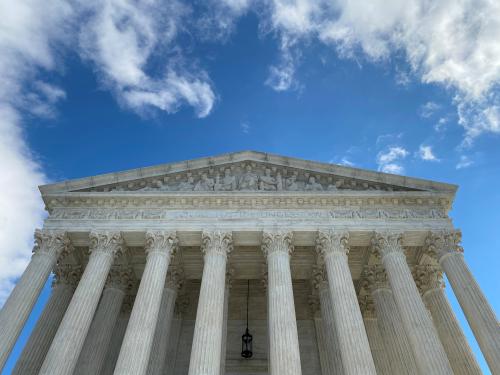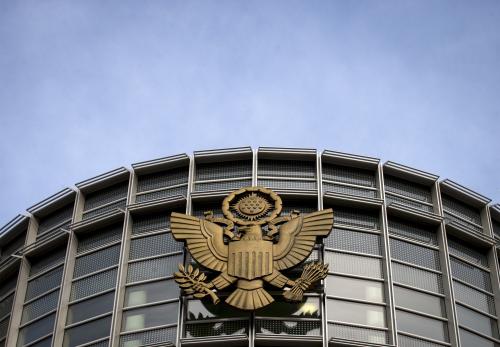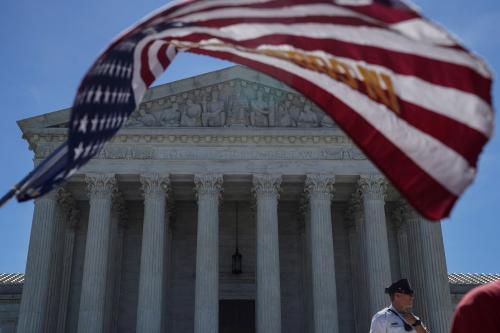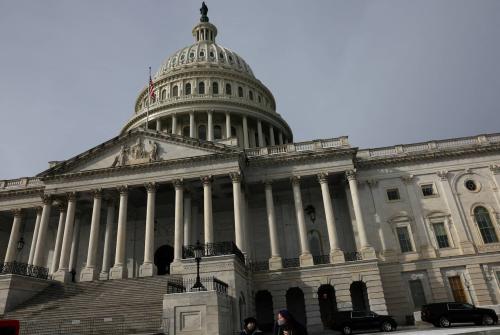President Trump threatened during an April 15 pandemic briefing to “adjourn both chambers of Congress” because the Senate’s pro forma sessions prevented his making recess appointments. The threat will go nowhere for constitutional and practical reasons, and he has not pressed it. The administration and Senate Republicans, though, remain committed to confirming as many judges as possible, starting soon after May 4, the date the Senate reconvenes, with Majority Leader McConnell vowing to make judicial confirmations a top priority.
Trump frames judicial confirmations as a contest with his predecessors, consistent with his “presidency-as-reality-television” approach. His two metrics are, first, number of judges appointed. Of recent presidents, at this point he trails only Jimmy Carter. The other metric is the percentage they represent of all statutory judgeships. On that measure, despite his claim that “percentagewise, I blow everybody away except one person . . . George Washington,” he falls in the middle of the pack. As suggested below, he will probably be in the same comparative position on Inauguration Day 2021.
As a preliminary aside, both metrics depend on factors largely beyond presidential control, namely the availability of vacancies and a compliant Senate. Carter benefitted from a 1978 law creating 152 additional vacancies and substantial Senate majorities at a time that confirmations were routine. Trump inherited 103 vacancies (more than any recent predecessor but President Clinton’s 109) thanks largely to McConnell’s effectively shutting down confirmations in 2015-16 under President Obama. Trump’s Senate majority is slim but exceedingly compliant.
Table 1 shows Trump’s comparative standing on May 4, ranked by number of appointments.
Table 1—Judicial Appointments on May 4 of Fourth Year in Office
| Court of Appeals Appts | % of Court of Appeals Judgeships | All Appts* | % of All Judgeships | |
| Carter | 50 | 35% | 208 | 31% |
| Trump | 51 | 28% | 193 | 22% |
| Clinton | 30 | 17% | 186 | 22% |
| Bush 2 | 29 | 17% | 172 | 20% |
| Nixon | 37 | 34% | 170 | 33% |
| Bush 1 | 33 | 18% | 154 | 18% |
| Obama | 27 | 15% | 142 | 16% |
| Reagan | 25 | 15% | 137 | 8% |
| JFK-LBJ | 23 | 26% | 134 | 33% |
* Including Supreme Court and Court of International Trade
Table 2 suggests that Trump’s comparative standing at the end of four years will be the same. He needs only eleven more appointments to finish ahead of all but Carter.
Table 2—Trump’s May 4 Record Compared to Predecessors’ Four-year Records
| Court of Appeals Appts | % of Court of Appeals Judgeships | All Appts | % of All Judgeships | |
| Trump (5/4/20) | 51 | 28% | 193 | 22% |
| Carter | 59 | 41% | 261 | 39% |
| Bush 2 | 34 | 19% | 203 | 23% |
| Clinton | 30 | 17% | 203 | 24% |
| Nixon | 43 | 39% | 195 | 37% |
| Bush 1 | 42 | 23% | 193 | 23% |
| Obama | 30 | 17% | 173 | 20% |
| Reagan | 33 | 20% | 166 | 22% |
| JFK-LBJ | 28 | 32% | 148 | 36% |
But he will still be in the middle of the pack as to percentage of judgeships filled. Trump would need 146 more appointments to match Carter’s 39% of seats (when there were 672 statutory judgeships. There are now 870; 39% of 870 is 339, 146 more than 193). At least 18 appointments each month between now and December seems clearly beyond reach, even if enough vacancies materialized to which to appoint them. A slightly lower number to match the Nixon and Kennedy-Johnson percentages is similarly unrealistic.
But simply as to number of appointments, what about the 68 more Trump will need simply to match Carter’s number of appointments? And, because the courts of appeals (often but misleadingly called “circuit courts”) have been McConnell’s major preoccupation, is it realistic to expect eight more appointments to match Carter’s 59?
Adding 68 confirmations, including some to the courts of appeal, from May through December 2020 depends largely on:
- How long the Senate shutdown lasts
- How many vacancies are available
- How many more nominations are likely
- How many confirmations McConnell can push through
How long the Senate shutdown lasts
The longer the Senate isn’t confirming judges, the more difficult it will be for Trump to appoint 68 more of them. The chart below shows, however, that if the Senate starts confirming judges early in May 4 as McConnell intends, that the shutdown would not have greatly disadvantaged Trump compared to his recent predecessors.
How many vacancies are available
Presidents can only make appointments to vacant judgeships. There are, as of early May, 77 current or announced district vacancies, more than enough for 68 appointments.
There are, however, only two court of appeals vacancies—both with nominees. Assuming their confirmation, Trump would need six more vacancies to be able to appoint eight court of appeals judges. Plenty of court of appeals (circuit) judges now qualify by age and years of service to leave active status with salaries intact under the statutory retirement rule, thus creating vacancies. However, 38 of them are Democratic appointees, who are unlikely to retire and give Trump an appointment that a President Biden could otherwise make.
Twenty-eight Republican appointees are also “senior status” eligible. One can speculate whether judges who have spurned senior status for several or more years will rush to the exists in the remaining months of 2020. Ten have been eligible for ten or more years and another five for at least seven years.
According to press reports, McConnell has been calling judges urging them to retire and thus create vacancies for Trump to fill. McConnell also seemed receptive to talk-show host Hugh Hewitt’s April 22 suggestion that federal judges “turn in a resignation [sic] letter saying I will retire provided a successor is confirmed by December 31st and, if not, I am not retiring.” It’s not unusual for a judge to announce retirement “contingent upon confirmation of my successor.” Perhaps some would add the overtly partisan “but I will not execute the paperwork to effect a change of status if I disapprove of my successor’s appointer.”
How many more nominations are likely
In early May, 39 nominees were or soon will be pending at some stage in the Senate. McConnell and Trump could raise Trump’s four-year total to Carter’s 261 by finding 29 more nominees (and confirming them along with the 39 pending nominees). Because many of the current and announced district vacancies without nominees are in states with two Democratic senators, the administration would have to abandon its willingness so far to work to some degree with home-state Democratic senators to find mutually acceptable nominees. (Home-state Democratic senators have had no role in selecting Trump court of appeals nominees.)
How many confirmations McConnell can push through
Normally, it would be a challenge to confirm judges after June or July in a presidential election year, but these are not normal times. Republicans have 53 votes in the filibuster-free Senate that Democrats gave them. McConnell in early April told Hewitt “My motto for the rest of the year is leave no vacancy behind.” The Senate’s recent record shows some hope for the president—it confirmed 91 judges in May through December 2019. It did so, however, without pandemic-related recesses, demands to debate and enact vital COVID-19 legislation, and the call of the campaign trail keeping senators away from Washington.
Even if Trump loses the election, expect McConnell to try to have the lame-duck Republican Senate muster the quorums that would allow it to break precedent by confirming many judges after November. They will claim the need to make up for ground lost to the Senate shutdown—even if voting resumes soon, with only the modest loss of momentum they’ve suffered so far.
These data derive from the Federal Judicial Center’s Federal Judicial Biographical Database, vacancy data available on uscourts.gov, and the author.







Commentary
How close is President Trump to his goal of record-setting judicial appointments?
May 5, 2020